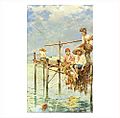Quintana Olleros facts for kids
Quick facts for kids
Quintana Olleras
|
|
|---|---|
| Born |
Blas Olleros y Quintana
1851 |
| Died | 1919 Florence, Italy
|
| Nationality | Spanish |
| Known for | Watercolourist |
| Movement | Orientalist themes |
Blas Olleros y Quintana (born 1851 in Ávila, Spain – died 1919 in Florence, Italy) was a Spanish artist. He painted people and landscapes. He mostly worked in Italy, using watercolors. He is famous for his paintings of Naples and his 'Orientalist' art.
Contents
Life of an Artist
Blas Olleros was born in 1851 in Piedrahita, a town in Spain. When he was 23, in 1874, the city of Ávila gave him money. This money, called a grant, helped him study art in Rome, Italy.
In his first year in Rome, he finished a painting called Nero in a Garden Setting, Surrounded by his Court. After his studies, he moved to Paris, France, for three years. There, he met another Spanish painter, Palmaroli. Palmaroli's art helped shape Olleros's own style.
In 1881, Blas Olleros went back to Rome. He became good friends with another Spanish painter, Agustin Salinas. For many years in the 1880s, Olleros lived in Naples, Italy. People there called him "Il Improvvisatore," which means "The Improviser." Italy became his home for most of his life.
In 1883, he sold two of his paintings, A Pompeii Woman and Seascape. He sold them through a gallery in Madrid, Spain, called Hernández. This gallery often sold watercolor paintings. After that, most of his art was sold through Hernández. Some of his works were also sold by art dealers in Germany and France.
Later in his life, he lived in Florence, Italy. He passed away there in 1919.
His Artworks
Blas Olleros painted many different things. He created landscapes, seascapes, and scenes with people. He also painted everyday life and historical moments. Many of his paintings showed scenes from Naples, especially its busy harbors.
He used both oil paints and watercolors. He usually signed his paintings "Blas Olleros." His most famous painting is Harem Scene, which you can see pictured here. It has been shown in many books.
Art Gallery
See also
 In Spanish: Blas Olleros y Quintana para niños
In Spanish: Blas Olleros y Quintana para niños
- List of Orientalist artists
- List of Spanish artists
- Orientalism
- List of people from Ávila, Spain








